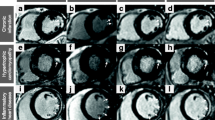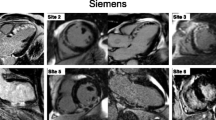Abstract
Purpose The reliable detection of myocardial perfusion defects and myocardial infarction (MI) is of great interest in the comprehensive workup of coronary artery disease. The aim of this study was to optimize the ability of contrast-enhanced cardiac multislice spiral computed tomography (MSCT) for detecting hypoperfused myocardium as surrogate marker of MI using a newly developed post-processing technique. Methods First a model-based software tool for semi-automated detection of the long axis of the left ventricle and assignment of left-ventricular segments was developed using a region growing algorithm and a point distribution model. To visualize changes of the myocardial contrast enhancement pattern color coding was performed after spreading of the attenuation values. 15 patients (12 men, mean age 57 ± 15 years) with a history of MI underwent cardiac MSCT (16 × 0.75 mm, 120 kV, 550 mA seff., 100 ml Iopromide) and contrast enhanced delayed enhanced magnetic resonance imaging (DE-MRI) after administration of 0.2 mmol Gd-DTPA/kg/bodyweight as reference standard. Presence of infarction was assessed from MSCT, post-processed MSCT images and DE-MRI using a 17-segment model of the left ventricle. Results On DE-MRI MI was present in 78/255 myocardial segments. From conventional MSCT images MI was detected in 63/255 segments (5 false positive; sensitivity 74.4%; specificity: 97.1%), while on post-processed images MI was assigned to 74/255 segments (6 false positive; sensitivity 87.2%; specificity: 96.6%). Agreement between DE-MRI and conventional MSCT images for detecting MI was κ = 0.756. Using post-processed images agreement improved to κ = 0.850. Conclusion MSCT detection of hypoperfused myocardium as surrogate for MI can be improved using dedicated post processing algorithms.


Similar content being viewed by others
References
Ohnesorge B, Flohr T, Becker C et al (2000) Cardiac imaging by means of electrocardiographically gated multisection spiral CT: initial experience. Radiology 217:564–571
Mahnken AH, Spuentrup E, Niethammer M et al (2003) Quantitative and qualitative assessment of left ventricular volume with ECG-gated multislice spiral CT: value of different image reconstruction algorithms in comparison to MRI. Acta Radiol 44:604–611
Juergens KU, Grude M, Maintz D et al (2004) Multi-detector row CT of left ventricular function with dedicated analysis software versus MR imaging: initial experience. Radiology 230:403–410
Mahnken AH, Koos R, Katoh M et al (2005) Assessment of myocardial viability in reperfused acute myocardial infarction using 16-slice computed tomography in comparison to magnetic resonance imaging. J Am Coll Cardiol 45:2042–2047
Kannel WB, Abbott RD (1984) Incidence and prognosis of unrecognised myocardial infarction. An update on the Framingham study. N Engl J Med 311:1144–1147
Wagner A, Mahrholdt H, Holly TA et al (2003) Contrast-enhanced MRI and routine single photon emission computed tomography (SPECT) perfusion imaging for detection of subendocardial myocardial infarcts: an imaging study. Lancet 361:374–379
Kim RJ, Fieno DS, Parrish TB et al (1999) Relationship of MRI delayed contrast enhancement to irreversible injury, infarct age, and contractile function. Circulation 100:1992–2002
Adams DF, Hessel SJ, Judy PF, Stein JA, Abrams HL (1976) Computed tomography of the normal and infarcted myocardium. AJR Am J Roentgenol 126:786–791
Schmermund A, Gerber T, Behrenbeck T et al (1998) Measurement of myocardial infarct size by electron beam computed tomography: a comparison with 99 mTc sestamibi. Invest Radiol 33:313–321
Ko SM, Seo JB, Hong MK et al (2006) Myocardial enhancement pattern in patients with acute myocardial infarction on two-phase contrast-enhanced ECG-gated multidetector-row computed tomography. Clin Radiol 61:417–422
Nikolaou K, Sanz J, Poon M et al (2005) Assessment of myocardial perfusion and viability from routine contrast-enhanced 16-detector-row computed tomography of the heart: preliminary results. Eur Radiol 15:864–871
Cerqueira MD, Weissman NJ, Dilsizian V et al (2002) Standardized myocardial segmentation and nomenclature for tomographic imaging of the heart: a statement for healthcare professionals from the Cardiac Imaging Committee of the Council on Clinical Cardiology of the American Heart Association. Circulation 105:539–542
Thompson BH, Stanford W (1994) Evaluation of cardiac function with ultrafast computed tomography. Radiol Clin North Am 32:537–551
Landis J, Koch GG (1977) The measurement of observer agreement for categorical data. Biometrics 33:159–174
Hessel SJ, Adams DF, Judy PF, Fishbein MC, Abrams HL (1978) Detection of myocardial ischemia in vitro by computed tomography. Radiology 127:413–418
Huber DJ, Lapray JF, Hessel SJ (1981) In vivo evaluation of experimental myocardial infarcts by ungated computed tomography. AJR Am J Roentgenol 136:469–473
Georgiou D, Bleiweis M, Brundage BH (1992) Conventional and ultrafast computed tomography in the detection of viable versus infarcted myocardium. Am J Card Imaging 6:228–236
Francone M, Carbone I, Danti M et al (2006) ECG-gated multi-detector row spiral CT in the assessment of myocardial infarction: correlation with non-invasive angiographic findings. Eur Radiol 16:15–24
Cootes TF, Taylor CJ, Cooper DH, Graham J (1995) Active shape models, their training and application. Comput Vis Image Underst 61:38–59
Fritz D, Rinck D, Unterhinninghofen R, Dillmann R, Scheuering M (2005) Automatic segmentation of the left ventricle and computation of diagnostic parameters using regiongrowing and a statistical model. In: Fitzpatrick JM, Reinhardt JM (eds) Medical imaging 2005: image processing, vol 5747. Proceedings of SPIE, San Diego, pp 1844–1854
Kass M, Witkin A, Terzopoulos D (1988) Snakes: active contour models. Int J Comput Vis 1:321–331
Tek H, Comaniciu D, Williams JP (2001) Vessel detection by mean shift based ray propagation. In: IEEE Workshop on mathematical methods in biomedical image analysis, Hawaii, pp 228–235
Gerber BL, Belge B, Legros GJ et al (2006) Characterization of acute and chronic myocardial infarcts by multidetector computed tomography: comparison with contrast-enhanced magnetic resonance. Circulation 113:823–833
Author information
Authors and Affiliations
Corresponding author
Appendix
Appendix
In the described approach a statistical segmentation method is applied that keeps track of learned shapes of the epi- and endocardium surfaces to avoid anatomically incorrect segmentation results and which is based on a Point Distribution Model (PDM) [19, 20]. Herein, a training set of patient-individual surfaces is defined by expert hand which is the basis for our segmentation technique. More specifically, each trained surface is sampled by regularly distributed n surface points and then a combined mean model \( {\bar {\mathbf x}}, \) representing an average epi- and endocardial point cloud, is calculated (Fig. 1a). By the application of a Principle Component Analysis (PCA) [19] of the training surfaces, we are able to get the covariance matrix S and its Eigenvectors in order to mathematically describe the different left ventricular learned shapes. Using this, one is able to approximate each trained dataset x by means of the average left ventricular model \( {\bar {\mathbf x}} \) by the following equation in a very intuitive mathematically description:
The matrix Φ contains the Eigenvectors φ i of the t-largest Eigenvalues λi of the covariance matrix S. The vector b is the model parameter vector that weights each mode such that
In order to enforce the limitation to plausible shapes, often a hard limit of \( \left| {b_i } \right| \le 3\sqrt {\lambda _i } \) is applied.
The segmentation of the myocardium starts by a single user click in the ascending aorta. Then, a region-growing algorithm is started that identifies the blood-pool of the left ventricle, which is the basis for the PDM model described above. By the application of a PCA of the blood-pool voxels, the main axis of the left ventricle is computed. Moreover, by means of morphological operators [20], one can fill the papillary muscles within the segmentation result and therefore extract the endocardial surface by the use of a snake technique which leads to very robust results in terms of the endocardium [21]. Since the basis of this approach is a technique that is based on anatomical statistics, we can apply the extracted endocardium surface to bring the algorithm (PDM) close to its final epicardial border. In order to get the final and correct anatomical epicardium surface, one has to detect the border within the image by robust image processing algorithms. For this purpose a combination of both, the Mahalanobis Distance [20] and the Mean-Shift technique is applied [22]. Furthermore, we introduce an expected grey value at the sample position which has been extracted from the shape-learning procedure which leads to the following weighted expression:
The equation above has to be maximized for each of the sampling rays along the surface normal. The parameters w ma, w me and w ex are weights in order to be able to emphasize each of the functional elements of Eq. 3.
Finally, in order to initialize the PDM procedure, including Eq. 3, and to determine the sample points along the epicardium surface, one has to introduce a LV-specific sampling scheme. Herein, at mid-ventricular position, we use parallel sampling, orthogonal to the LV long-axis. At apical and basal position, a half-spherical sampling shape is applied (Fig. 1b). In consequence, sampling rays, which apply Eq. 3, are defined in circular order, rotating around the LV long-axis. The length of the long-axis is defined by the region-growing in combination with the PCA of the blood-pool voxels. The Eigenvectors can then be used for correct scaling of the LV to the mean shape.
After extraction of the myocardium from the MSCT data set a 17 segment model of the left ventricle is automatically assigned to the segmentation results [12]. Thereafter a dedicated visual improvement technique was introduced in order to enhance the visual perception of possibly infarcted areas. For this purpose the intensity interval of the myocardium mass voxels has to be spread. For the described post-processing technique an empiric range from 50 HU to 140 HU that was considered to be representative for diagnostic results was used [4, 23]. This interval is stretched up to 1000 units including a linear interpolation of the voxels. Intensities below or above are not taken into account.
Finally, the selected voxels were colored using a predefined lookup table ranging from blue via green to yellow and red and which only takes care of the relative grey values of the myocardial voxels. The lower the perfusion of the myocardial tissue, the lower is the intensity in the original image. Such tissue is colored in blue. In the opposite direction, the better the perfusion, the brighter are the voxel intensities. In this direction the scale ends with yellow.
Rights and permissions
About this article
Cite this article
Mahnken, A.H., Lautenschläger, S., Fritz, D. et al. Perfusion weighted color maps for enhanced visualization of myocardial infarction by MSCT: preliminary experience. Int J Cardiovasc Imaging 24, 883–890 (2008). https://doi.org/10.1007/s10554-008-9318-0
Received:
Accepted:
Published:
Issue Date:
DOI: https://doi.org/10.1007/s10554-008-9318-0




